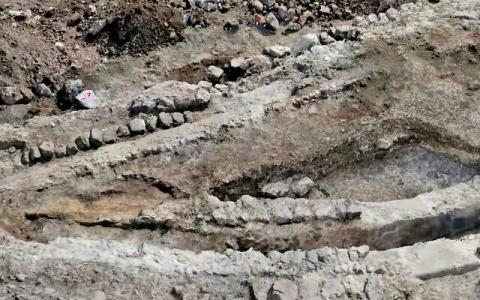Archaeologists have discovered a new segment of the aqueduct in Jerusalem
Used until the British Mandate, when it was discarded for new electric pump technology, the newly uncovered segment of the Hasmonean-era water line — currently some 40 meters — will be conserved and integrated into a neighborhood park in cooperation with the Jerusalem Municipality and the Moriah Jerusalem Development Corporation.
“This is a real historical monument of the city,” Israel Antiquities Authority archaeologist Yaakov Billig, an expert in ancient aqueducts, told The Times of Israel on Sunday, Jerusalem Day.
It was used and maintained (or not) by a succession of rulers, said Billig, including those from the three major monotheistic religions, through the end of the Ottoman Empire, when it began to increasingly crack and decay.
Since it was in use until relatively recently, modern researchers have long been aware of the location of the aqueduct and it appears in maps of Ottoman-era Jerusalem. In excavations led by the IAA’s Alexander Wiegmann, all the eroded dirt and fill has been removed from the new section, which will soon be readied for tourists to visit.
Billig said that the new excavations are not being conducting merely for the sake of nostalgia, however. Rather, researchers are still amazed and even somewhat mystified by the precision technology constructed in antiquity without the aid of GPS or modern computation methods.
The Low-Level Aqueduct dates to circa 100 BCE, said Billig, and was used for public needs specifically at the Temple Mount. It was at the outer limits of the contemporary technology, he said. “Compared to what there was before, it was a revolution,” said Billig. Previously, Jerusalem residents “had to either go all the way down to the spring and schlep it back home,” or manage water captured by cisterns under their house that were filled with rainwater that wouldn’t be replenished until the next rainy season.
With the advent of the electric pump, however, “just like a lot of old things, it was neglected.” Billig said that over the course of the aqueduct’s history, it required a lot of upkeep.
“When the authorities were strong enough and had the budget and interest to do so, [the water] made a difference; it was an extra boost of water supply to the city.” When the local authorities weren’t dominant, passing shepherds would poke holes in the pipeline to water their flocks, for example, and newspapers of the 19th century were riddled with reports of water outages and pipe repairs.
“About 100 years ago, a whole new modern invention called electricity could now pump water up hill,” said Billig, whereupon local authorities “didn’t bother with the aqueduct” and it was covered with debris and eroded soil.
“Each new solution is revolutionary and gives more water, better water, and now you can neglect the old thing,” said Billig, pointing to new desalination technology. “Today there is no threat of a water shortage, which is something that was a risk a few years ago.”
Amanda Borschel-Dan

